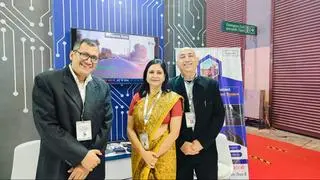The adage ‘What’s in a name’ comes back to haunt Sharan Grandigae every time he thinks he has a cool idea. His first start-up was called Dhraya. No one understood its meaning and neither did Sharan.
He then went on to develop a new product called Obi, which, Sharan explains, is the “sash that you wear on the kimono, the traditional Japanese dress, that keeps all the levels together”. Since the software product in question took care of the inventory of a company, “which has many layers to it, we derived a name from that idea,” says Sharan.
Unfortunately, that, too, sank without a trace. Then Redd was born. “In Gaelic, it means to set things right. That’s essentially what we do. You come to us with a problem and we figure out the solution,” says Sharan,
That name stuck and so did the business. Sharan Grandigae is the Founder and CEO of Redd Experience Design, a user experience (UX) design company established in 2015, and based out of Indiranagar, Bengaluru.

Early years
Sharan started his first company along with his twin brother in 2000, while still at Drexel University in the US, where he studied Marketing and Management Information Systems. “There was a business plan competition, where one could pitch ideas about start-ups,” says Sharan. Organised by an incubator at Drexel University, “the prize money was $15,000, $10,000 and $5,000, respectively. We bagged the third prize,” says the self-trained software developer.
The Drexel product that got Sharan the prize money was a management information system, “a software equivalent of what Google Analytics does today.”
Sharan then ran a company with partners called Dhraya Corporation, which focussed on building marketing technologies, part of the incubator at Drexel University, building custom software for small- and medium-size businesses in Philadelphia.
Six years in the US building custom software, the initial stirrings had started, of setting up a dedicated user experience design start-up company, to focus on developing interfaces and experiences that humanise technology.
Twin brother Charan came back to India in 2006. Sharan followed him a year later, “since we started getting clients here who were willing to pay the same amount as in the US.” The duo set up a development centre in Bengaluru and started getting clients “which was completely unanticipated.”
Several small projects came their way. “We developed Obi (with the kimono attributes) and sold it to a few clients from tyre resellers to jewellers. The software helps companies manage their inventory. It was a simple idea and it served well at the time,” says Sharan.
The only hurdle — the name did not ring a bell.
In 2007, the duo was asked to simplify the Tally software. The specific request came in from small businesses, which could not understand the technical details and wanted something less complicated to handle their affairs, said Sharan.
“We took a user-centric approach and devised a simple system. With two hours of training, anyone could start operating and using it. That essentially is user experience. That was my entry into the field of UX,” says Sharan.
It was at that time one of the managers of Adobe got in touch. “It was a question posed on a Q&A forum, can anyone build an Adobe flash builder? Are there any design masters in India? It was a very arrogant question but a very sweet one and it made me respond immediately,” says Sharan, who went in for an interview and bagged the job.
Sharan had never worked for anybody. “I joined Adobe in 2009 as a UX designer, but after more than three years, quit in April 2013. When I left my designation was Designer Manager for India,” says Sharan.
Quitting pangs?
Leaving a stable job could have had its problems, but not in Sharan’s household. “My dad used to be a lawyer before he turned entrepreneur. In fact, my entire family is full of entrepreneurs. My elder brother is in the jewellery business, and another is in construction. My sister is with a VC arm in California. As the youngest of four kids I was always encouraged to follow my dream,” he points out.
Whilst working with a bunch of smaller companies, Sharan realised the workload was too much.
“I decided to start a UX design studio and called it Redd. I decided to keep the name straightforward this time, for our design style was attracting German and Scandinavian clients,” he said, adding as an aside: “I also wanted a brand that would be pronounceable to begin with.”
The clients included Infosys, omni channel furniture retailer Urban Ladder, designer jewellery firm Bluestone, eyewear company Lenskart, Asian Paints and L&T Infotech.
Though Infosys and Bluestone have their own design teams, “they like to hire freelancers, who come to the table with a lot of experience and from a variety of fields.”
Sharan says he works with constraints. “The success of a design is how well it functions within its constraints. Though designers are all opinionated, the success of a design is how well one executes it. At such times, having a clear point of view is extremely necessary,” he adds.
Sharan spent ₹6 lakh to set up a firm in 2015. The capital was recovered in the first year itself, he says. One of the biggest fears as an entrepreneur is failure, “one has to keep improving. Use agile development. It’s a rat race, but one has to be restrained and disciplined.”








Comments
Comments have to be in English, and in full sentences. They cannot be abusive or personal. Please abide by our community guidelines for posting your comments.
We have migrated to a new commenting platform. If you are already a registered user of TheHindu Businessline and logged in, you may continue to engage with our articles. If you do not have an account please register and login to post comments. Users can access their older comments by logging into their accounts on Vuukle.